Impact of Business Information Systems on Healthcare Performance
VerifiedAdded on 2023/01/11
|6
|1335
|91
Report
AI Summary
This report examines the critical role of Business Information Systems (BIS) in the healthcare sector, particularly within the context of the NHS in the UK. It defines BIS as IT-driven procedures that generate essential business information. The report emphasizes the importance of the balance scorecard as an effective BIS tool for healthcare, enabling organizations to assess their market position and make informed decisions. The main body discusses how BIS improves patient care through information management related to patients, clinics, and financial data. It highlights the advantages of the balance scorecard, including improved communication, performance reporting, process alignment, and effective information management. The report also details various Key Performance Indicators (KPIs) used to measure healthcare effectiveness, such as patient focus, average hospital stay, treatment costs, staff-to-patient ratios, and claim denial rates. It concludes that BIS, especially through KPIs, helps healthcare providers enhance services and address areas needing improvement, ultimately leading to better patient outcomes and efficient resource management.

Business Information Systems
1
1
Paraphrase This Document
Need a fresh take? Get an instant paraphrase of this document with our AI Paraphraser
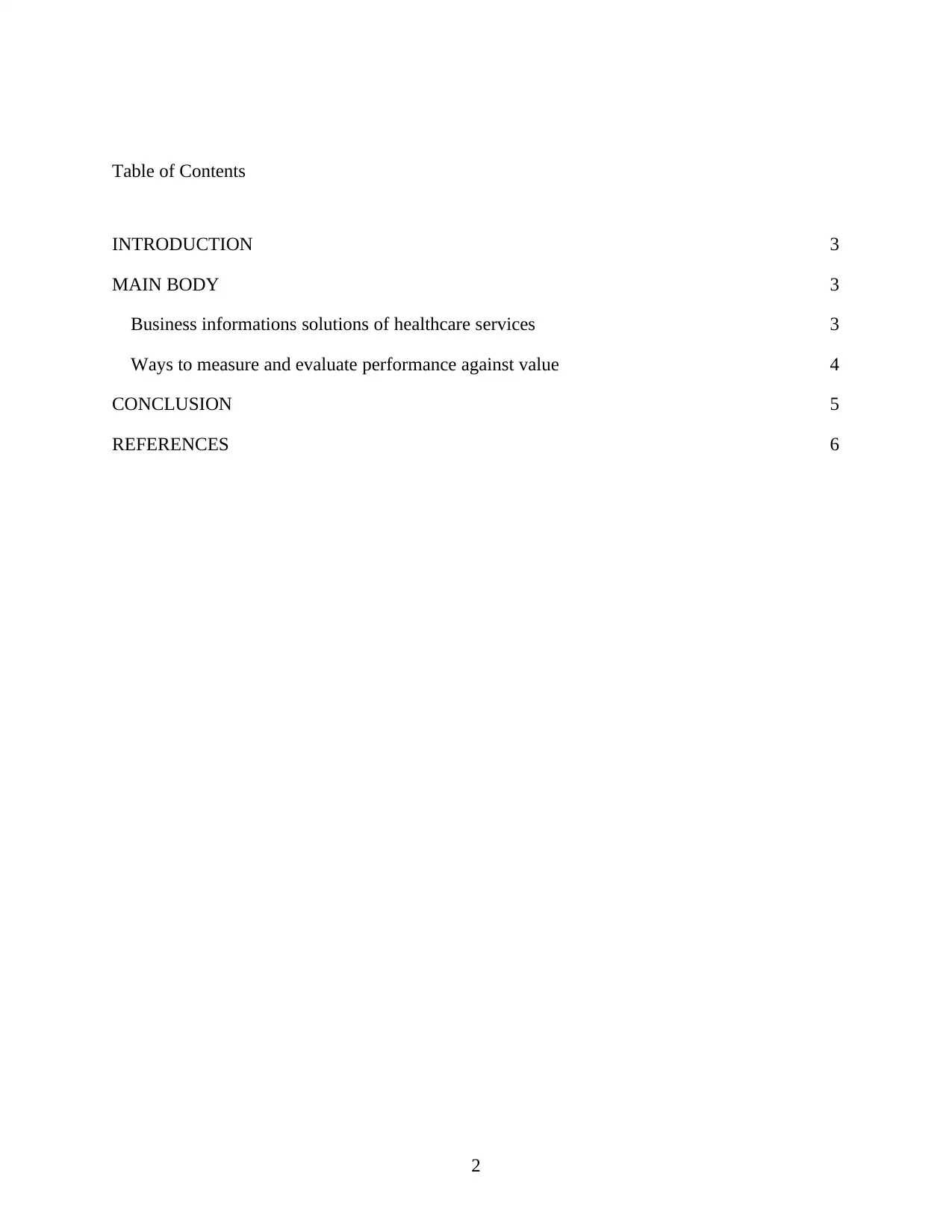
Table of Contents
INTRODUCTION 3
MAIN BODY 3
Business informations solutions of healthcare services 3
Ways to measure and evaluate performance against value 4
CONCLUSION 5
REFERENCES 6
2
INTRODUCTION 3
MAIN BODY 3
Business informations solutions of healthcare services 3
Ways to measure and evaluate performance against value 4
CONCLUSION 5
REFERENCES 6
2
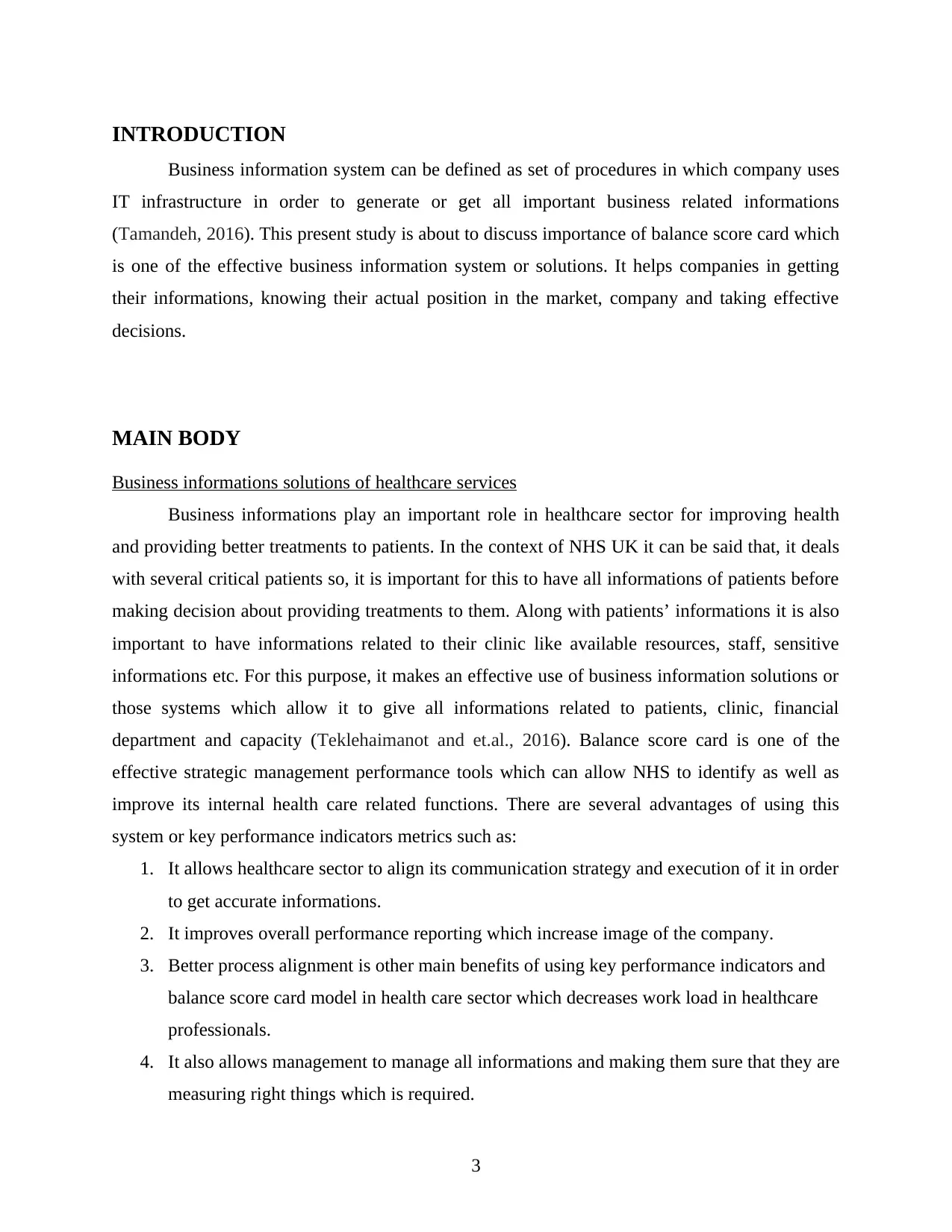
INTRODUCTION
Business information system can be defined as set of procedures in which company uses
IT infrastructure in order to generate or get all important business related informations
(Tamandeh, 2016). This present study is about to discuss importance of balance score card which
is one of the effective business information system or solutions. It helps companies in getting
their informations, knowing their actual position in the market, company and taking effective
decisions.
MAIN BODY
Business informations solutions of healthcare services
Business informations play an important role in healthcare sector for improving health
and providing better treatments to patients. In the context of NHS UK it can be said that, it deals
with several critical patients so, it is important for this to have all informations of patients before
making decision about providing treatments to them. Along with patients’ informations it is also
important to have informations related to their clinic like available resources, staff, sensitive
informations etc. For this purpose, it makes an effective use of business information solutions or
those systems which allow it to give all informations related to patients, clinic, financial
department and capacity (Teklehaimanot and et.al., 2016). Balance score card is one of the
effective strategic management performance tools which can allow NHS to identify as well as
improve its internal health care related functions. There are several advantages of using this
system or key performance indicators metrics such as:
1. It allows healthcare sector to align its communication strategy and execution of it in order
to get accurate informations.
2. It improves overall performance reporting which increase image of the company.
3. Better process alignment is other main benefits of using key performance indicators and
balance score card model in health care sector which decreases work load in healthcare
professionals.
4. It also allows management to manage all informations and making them sure that they are
measuring right things which is required.
3
Business information system can be defined as set of procedures in which company uses
IT infrastructure in order to generate or get all important business related informations
(Tamandeh, 2016). This present study is about to discuss importance of balance score card which
is one of the effective business information system or solutions. It helps companies in getting
their informations, knowing their actual position in the market, company and taking effective
decisions.
MAIN BODY
Business informations solutions of healthcare services
Business informations play an important role in healthcare sector for improving health
and providing better treatments to patients. In the context of NHS UK it can be said that, it deals
with several critical patients so, it is important for this to have all informations of patients before
making decision about providing treatments to them. Along with patients’ informations it is also
important to have informations related to their clinic like available resources, staff, sensitive
informations etc. For this purpose, it makes an effective use of business information solutions or
those systems which allow it to give all informations related to patients, clinic, financial
department and capacity (Teklehaimanot and et.al., 2016). Balance score card is one of the
effective strategic management performance tools which can allow NHS to identify as well as
improve its internal health care related functions. There are several advantages of using this
system or key performance indicators metrics such as:
1. It allows healthcare sector to align its communication strategy and execution of it in order
to get accurate informations.
2. It improves overall performance reporting which increase image of the company.
3. Better process alignment is other main benefits of using key performance indicators and
balance score card model in health care sector which decreases work load in healthcare
professionals.
4. It also allows management to manage all informations and making them sure that they are
measuring right things which is required.
3
⊘ This is a preview!⊘
Do you want full access?
Subscribe today to unlock all pages.

Trusted by 1+ million students worldwide
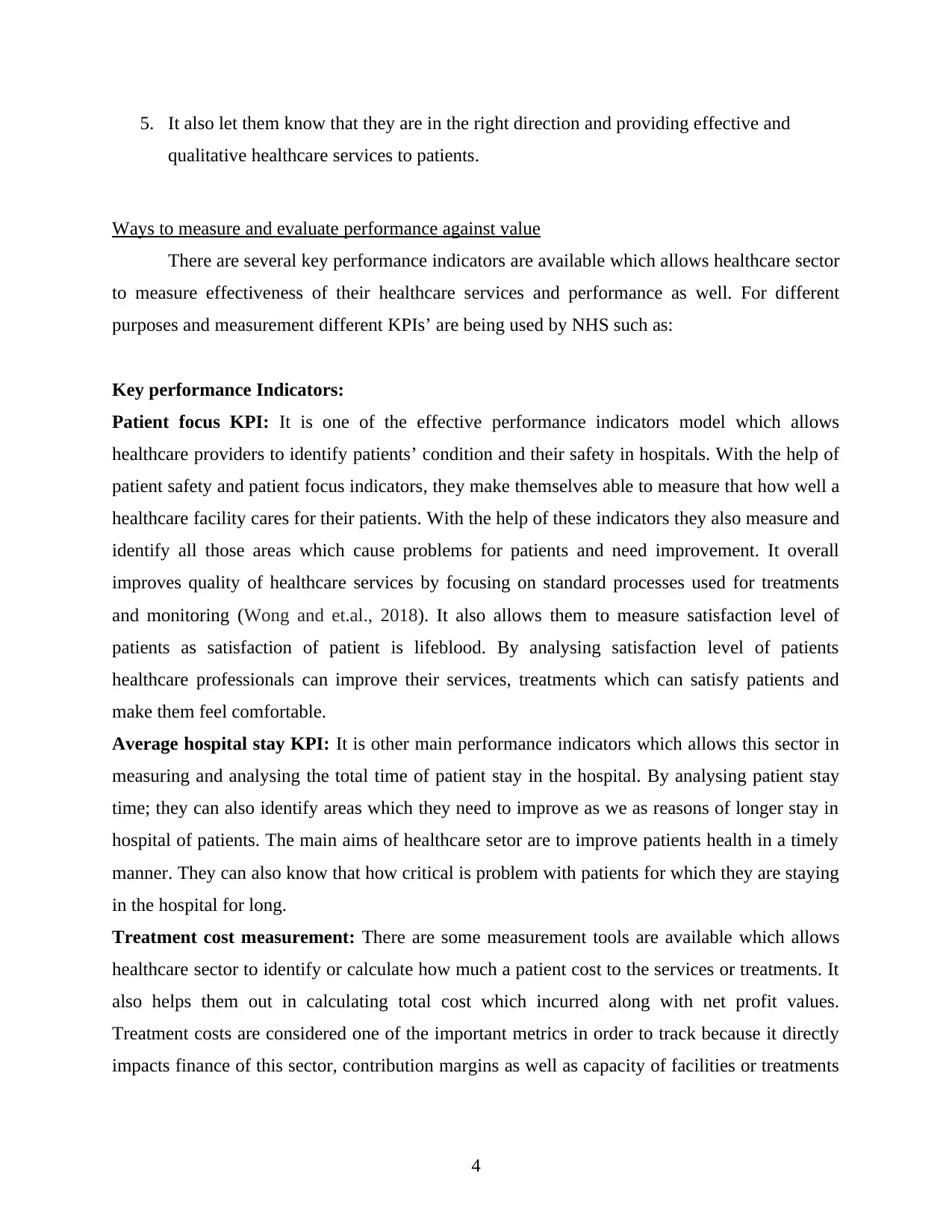
5. It also let them know that they are in the right direction and providing effective and
qualitative healthcare services to patients.
Ways to measure and evaluate performance against value
There are several key performance indicators are available which allows healthcare sector
to measure effectiveness of their healthcare services and performance as well. For different
purposes and measurement different KPIs’ are being used by NHS such as:
Key performance Indicators:
Patient focus KPI: It is one of the effective performance indicators model which allows
healthcare providers to identify patients’ condition and their safety in hospitals. With the help of
patient safety and patient focus indicators, they make themselves able to measure that how well a
healthcare facility cares for their patients. With the help of these indicators they also measure and
identify all those areas which cause problems for patients and need improvement. It overall
improves quality of healthcare services by focusing on standard processes used for treatments
and monitoring (Wong and et.al., 2018). It also allows them to measure satisfaction level of
patients as satisfaction of patient is lifeblood. By analysing satisfaction level of patients
healthcare professionals can improve their services, treatments which can satisfy patients and
make them feel comfortable.
Average hospital stay KPI: It is other main performance indicators which allows this sector in
measuring and analysing the total time of patient stay in the hospital. By analysing patient stay
time; they can also identify areas which they need to improve as we as reasons of longer stay in
hospital of patients. The main aims of healthcare setor are to improve patients health in a timely
manner. They can also know that how critical is problem with patients for which they are staying
in the hospital for long.
Treatment cost measurement: There are some measurement tools are available which allows
healthcare sector to identify or calculate how much a patient cost to the services or treatments. It
also helps them out in calculating total cost which incurred along with net profit values.
Treatment costs are considered one of the important metrics in order to track because it directly
impacts finance of this sector, contribution margins as well as capacity of facilities or treatments
4
qualitative healthcare services to patients.
Ways to measure and evaluate performance against value
There are several key performance indicators are available which allows healthcare sector
to measure effectiveness of their healthcare services and performance as well. For different
purposes and measurement different KPIs’ are being used by NHS such as:
Key performance Indicators:
Patient focus KPI: It is one of the effective performance indicators model which allows
healthcare providers to identify patients’ condition and their safety in hospitals. With the help of
patient safety and patient focus indicators, they make themselves able to measure that how well a
healthcare facility cares for their patients. With the help of these indicators they also measure and
identify all those areas which cause problems for patients and need improvement. It overall
improves quality of healthcare services by focusing on standard processes used for treatments
and monitoring (Wong and et.al., 2018). It also allows them to measure satisfaction level of
patients as satisfaction of patient is lifeblood. By analysing satisfaction level of patients
healthcare professionals can improve their services, treatments which can satisfy patients and
make them feel comfortable.
Average hospital stay KPI: It is other main performance indicators which allows this sector in
measuring and analysing the total time of patient stay in the hospital. By analysing patient stay
time; they can also identify areas which they need to improve as we as reasons of longer stay in
hospital of patients. The main aims of healthcare setor are to improve patients health in a timely
manner. They can also know that how critical is problem with patients for which they are staying
in the hospital for long.
Treatment cost measurement: There are some measurement tools are available which allows
healthcare sector to identify or calculate how much a patient cost to the services or treatments. It
also helps them out in calculating total cost which incurred along with net profit values.
Treatment costs are considered one of the important metrics in order to track because it directly
impacts finance of this sector, contribution margins as well as capacity of facilities or treatments
4
Paraphrase This Document
Need a fresh take? Get an instant paraphrase of this document with our AI Paraphraser
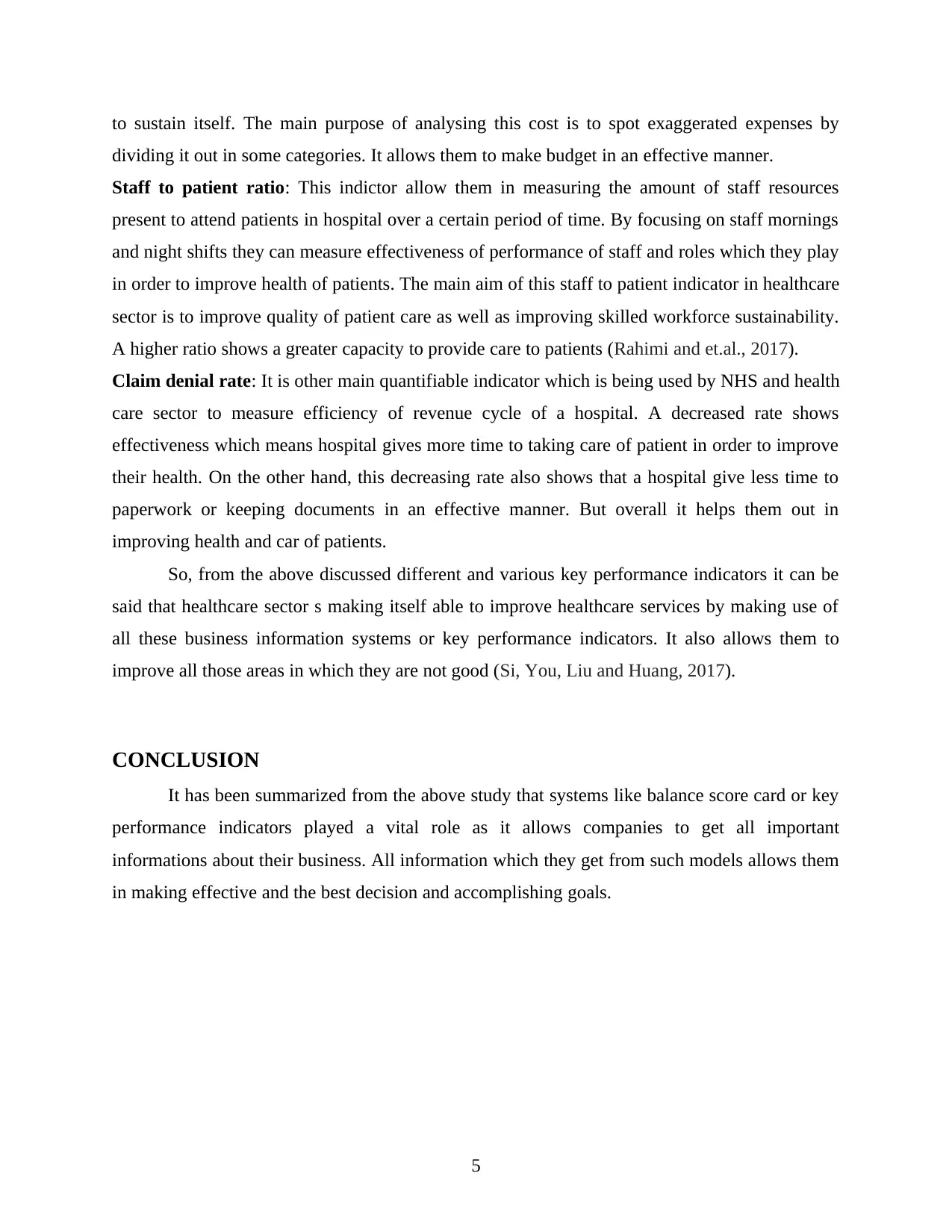
to sustain itself. The main purpose of analysing this cost is to spot exaggerated expenses by
dividing it out in some categories. It allows them to make budget in an effective manner.
Staff to patient ratio: This indictor allow them in measuring the amount of staff resources
present to attend patients in hospital over a certain period of time. By focusing on staff mornings
and night shifts they can measure effectiveness of performance of staff and roles which they play
in order to improve health of patients. The main aim of this staff to patient indicator in healthcare
sector is to improve quality of patient care as well as improving skilled workforce sustainability.
A higher ratio shows a greater capacity to provide care to patients (Rahimi and et.al., 2017).
Claim denial rate: It is other main quantifiable indicator which is being used by NHS and health
care sector to measure efficiency of revenue cycle of a hospital. A decreased rate shows
effectiveness which means hospital gives more time to taking care of patient in order to improve
their health. On the other hand, this decreasing rate also shows that a hospital give less time to
paperwork or keeping documents in an effective manner. But overall it helps them out in
improving health and car of patients.
So, from the above discussed different and various key performance indicators it can be
said that healthcare sector s making itself able to improve healthcare services by making use of
all these business information systems or key performance indicators. It also allows them to
improve all those areas in which they are not good (Si, You, Liu and Huang, 2017).
CONCLUSION
It has been summarized from the above study that systems like balance score card or key
performance indicators played a vital role as it allows companies to get all important
informations about their business. All information which they get from such models allows them
in making effective and the best decision and accomplishing goals.
5
dividing it out in some categories. It allows them to make budget in an effective manner.
Staff to patient ratio: This indictor allow them in measuring the amount of staff resources
present to attend patients in hospital over a certain period of time. By focusing on staff mornings
and night shifts they can measure effectiveness of performance of staff and roles which they play
in order to improve health of patients. The main aim of this staff to patient indicator in healthcare
sector is to improve quality of patient care as well as improving skilled workforce sustainability.
A higher ratio shows a greater capacity to provide care to patients (Rahimi and et.al., 2017).
Claim denial rate: It is other main quantifiable indicator which is being used by NHS and health
care sector to measure efficiency of revenue cycle of a hospital. A decreased rate shows
effectiveness which means hospital gives more time to taking care of patient in order to improve
their health. On the other hand, this decreasing rate also shows that a hospital give less time to
paperwork or keeping documents in an effective manner. But overall it helps them out in
improving health and car of patients.
So, from the above discussed different and various key performance indicators it can be
said that healthcare sector s making itself able to improve healthcare services by making use of
all these business information systems or key performance indicators. It also allows them to
improve all those areas in which they are not good (Si, You, Liu and Huang, 2017).
CONCLUSION
It has been summarized from the above study that systems like balance score card or key
performance indicators played a vital role as it allows companies to get all important
informations about their business. All information which they get from such models allows them
in making effective and the best decision and accomplishing goals.
5
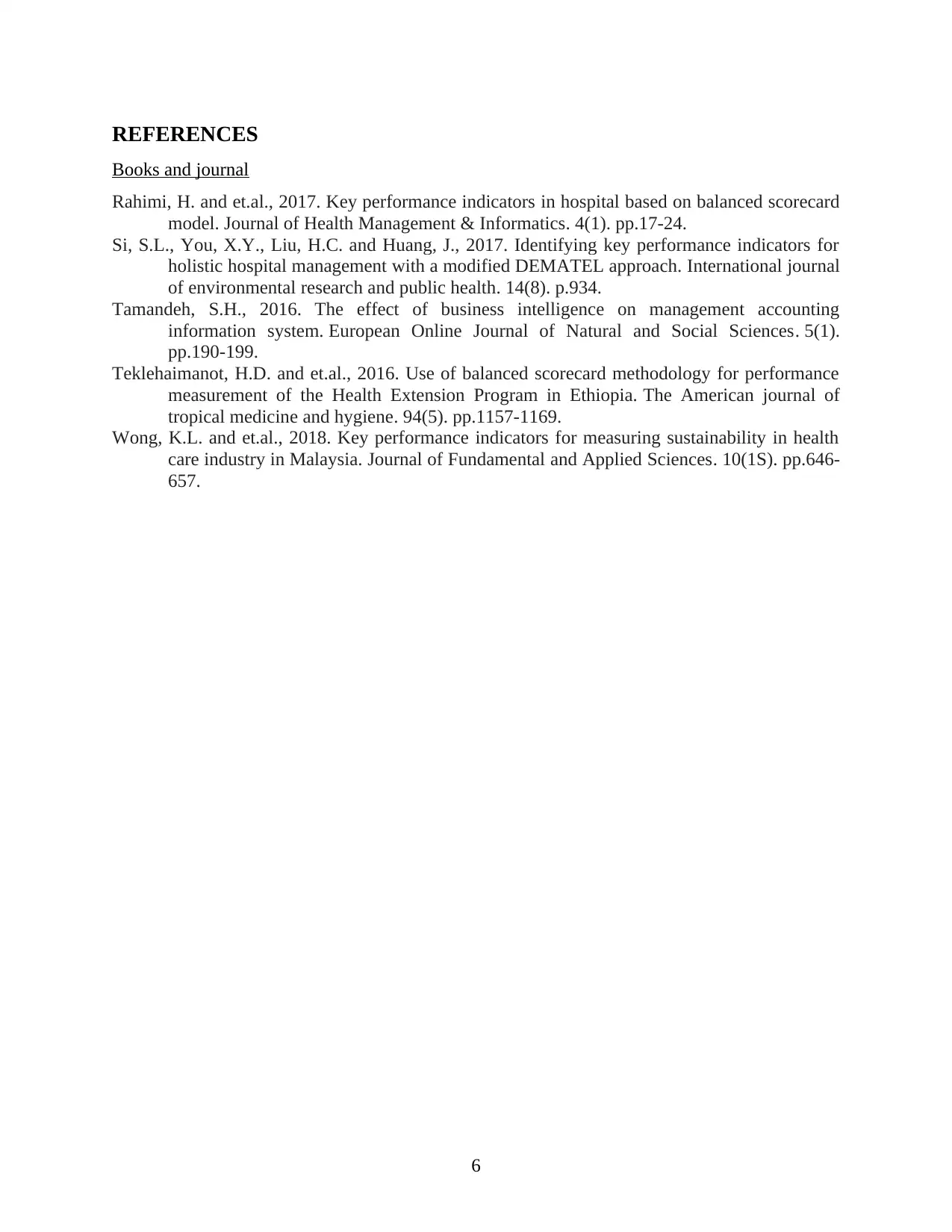
REFERENCES
Books and journal
Rahimi, H. and et.al., 2017. Key performance indicators in hospital based on balanced scorecard
model. Journal of Health Management & Informatics. 4(1). pp.17-24.
Si, S.L., You, X.Y., Liu, H.C. and Huang, J., 2017. Identifying key performance indicators for
holistic hospital management with a modified DEMATEL approach. International journal
of environmental research and public health. 14(8). p.934.
Tamandeh, S.H., 2016. The effect of business intelligence on management accounting
information system. European Online Journal of Natural and Social Sciences. 5(1).
pp.190-199.
Teklehaimanot, H.D. and et.al., 2016. Use of balanced scorecard methodology for performance
measurement of the Health Extension Program in Ethiopia. The American journal of
tropical medicine and hygiene. 94(5). pp.1157-1169.
Wong, K.L. and et.al., 2018. Key performance indicators for measuring sustainability in health
care industry in Malaysia. Journal of Fundamental and Applied Sciences. 10(1S). pp.646-
657.
6
Books and journal
Rahimi, H. and et.al., 2017. Key performance indicators in hospital based on balanced scorecard
model. Journal of Health Management & Informatics. 4(1). pp.17-24.
Si, S.L., You, X.Y., Liu, H.C. and Huang, J., 2017. Identifying key performance indicators for
holistic hospital management with a modified DEMATEL approach. International journal
of environmental research and public health. 14(8). p.934.
Tamandeh, S.H., 2016. The effect of business intelligence on management accounting
information system. European Online Journal of Natural and Social Sciences. 5(1).
pp.190-199.
Teklehaimanot, H.D. and et.al., 2016. Use of balanced scorecard methodology for performance
measurement of the Health Extension Program in Ethiopia. The American journal of
tropical medicine and hygiene. 94(5). pp.1157-1169.
Wong, K.L. and et.al., 2018. Key performance indicators for measuring sustainability in health
care industry in Malaysia. Journal of Fundamental and Applied Sciences. 10(1S). pp.646-
657.
6
⊘ This is a preview!⊘
Do you want full access?
Subscribe today to unlock all pages.

Trusted by 1+ million students worldwide
1 out of 6
Related Documents
Your All-in-One AI-Powered Toolkit for Academic Success.
+13062052269
info@desklib.com
Available 24*7 on WhatsApp / Email
![[object Object]](/_next/static/media/star-bottom.7253800d.svg)
Unlock your academic potential
Copyright © 2020–2025 A2Z Services. All Rights Reserved. Developed and managed by ZUCOL.





